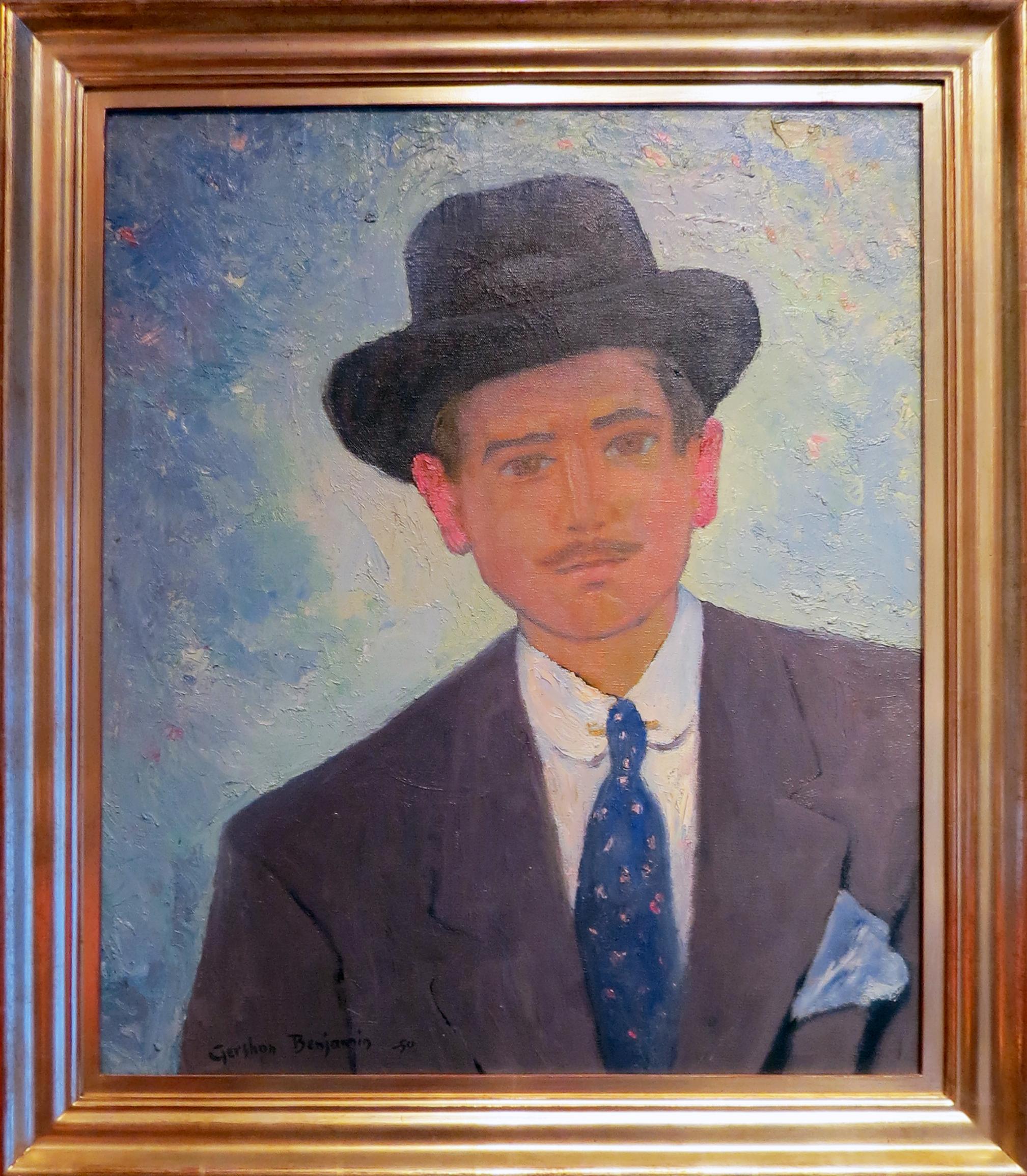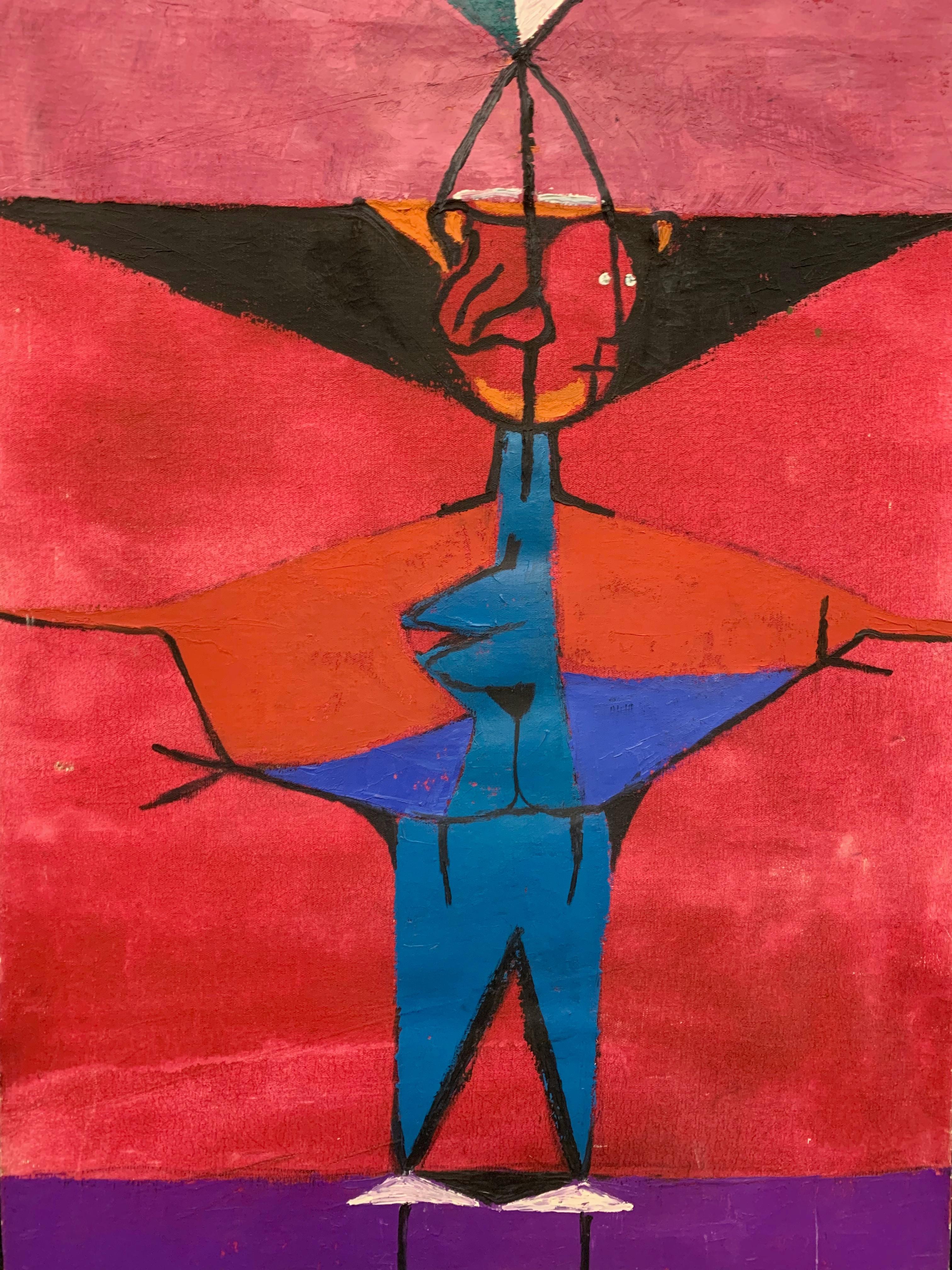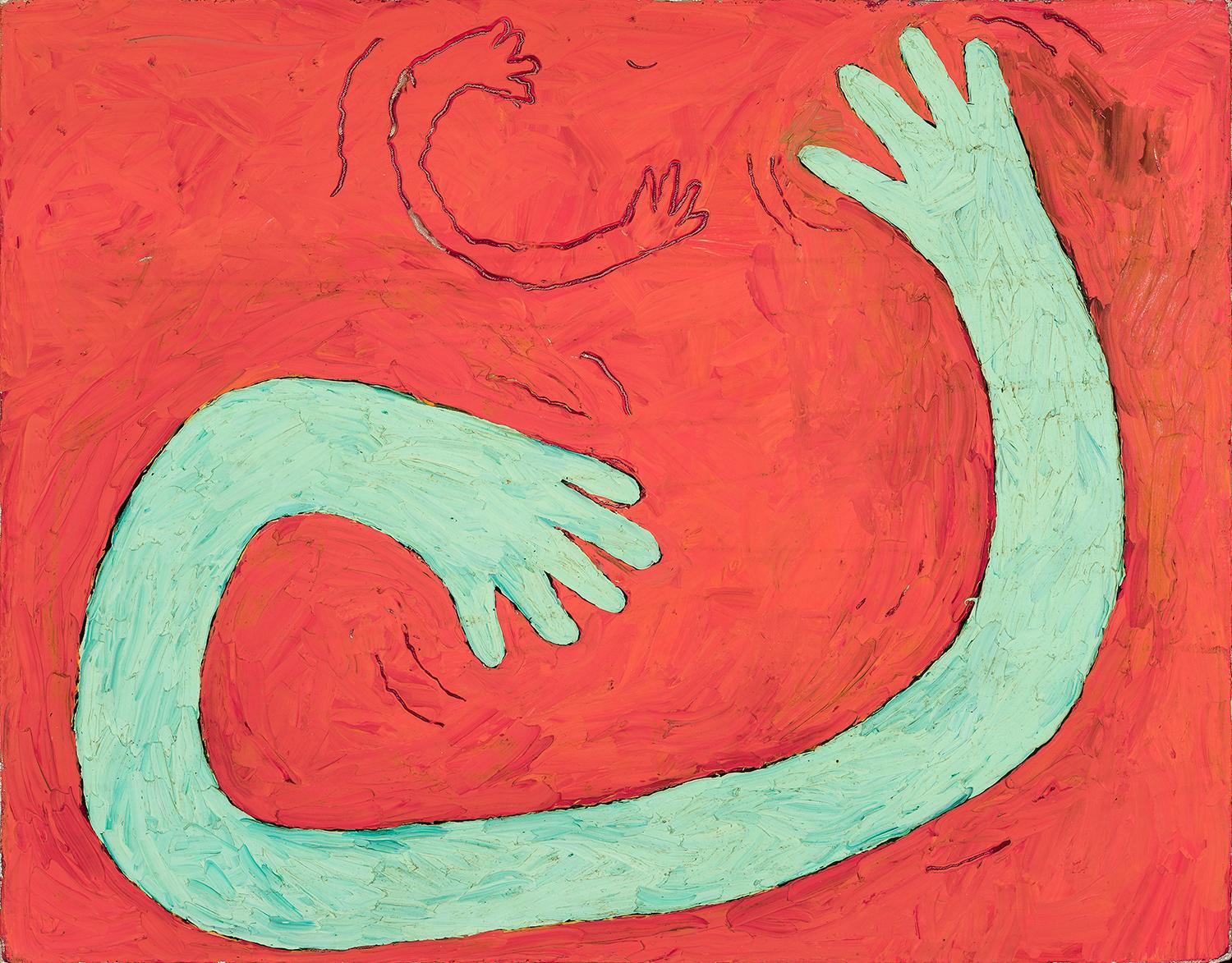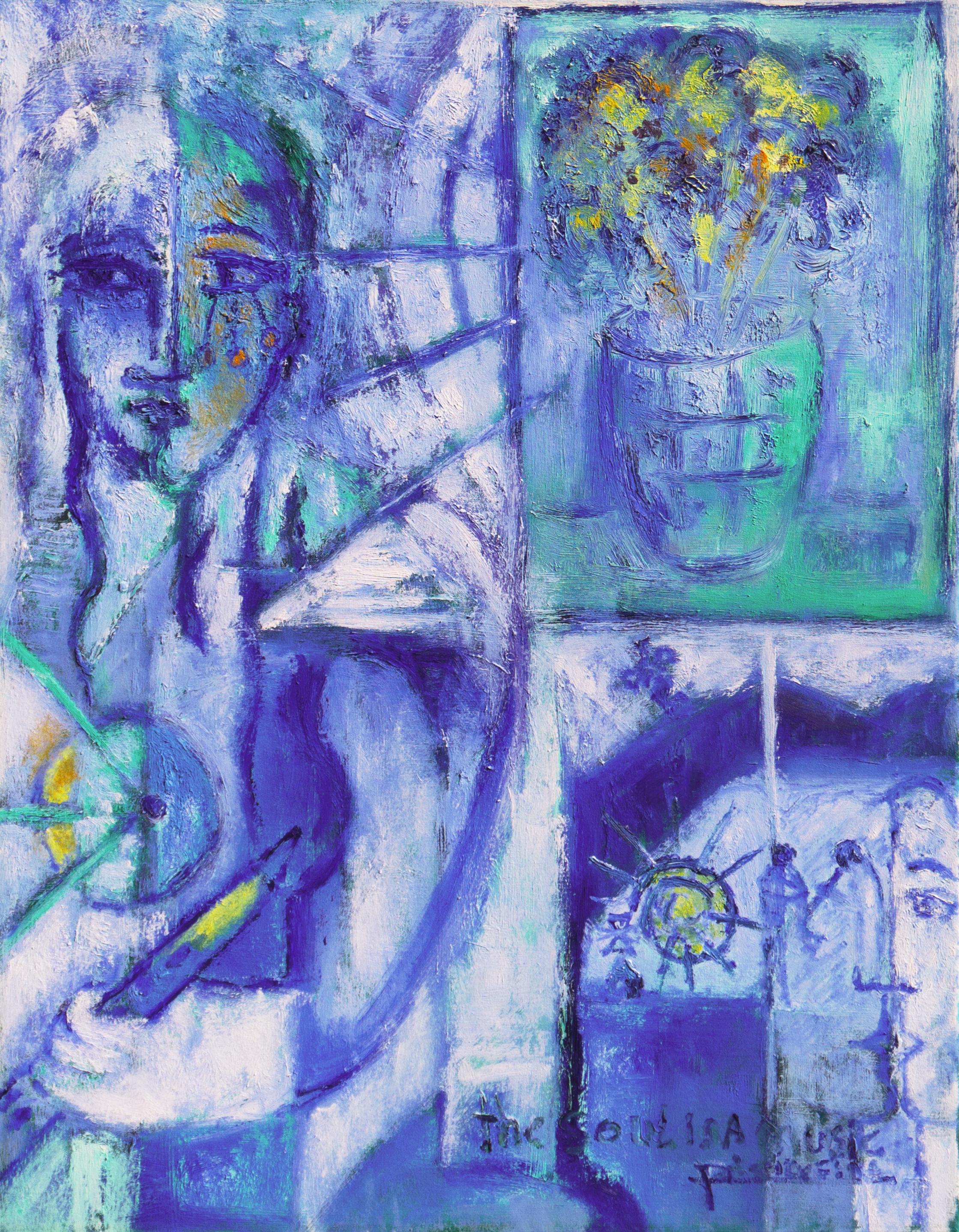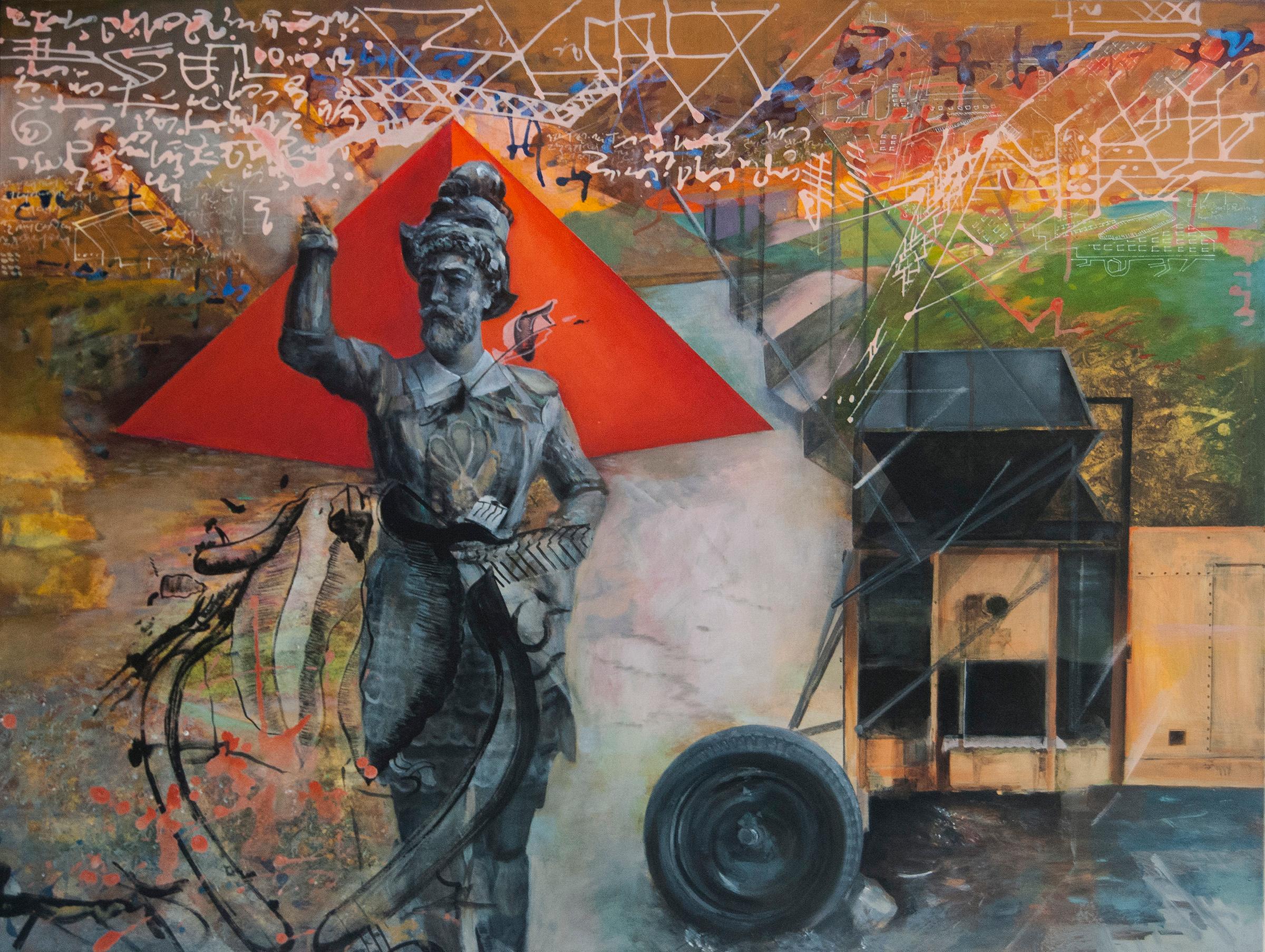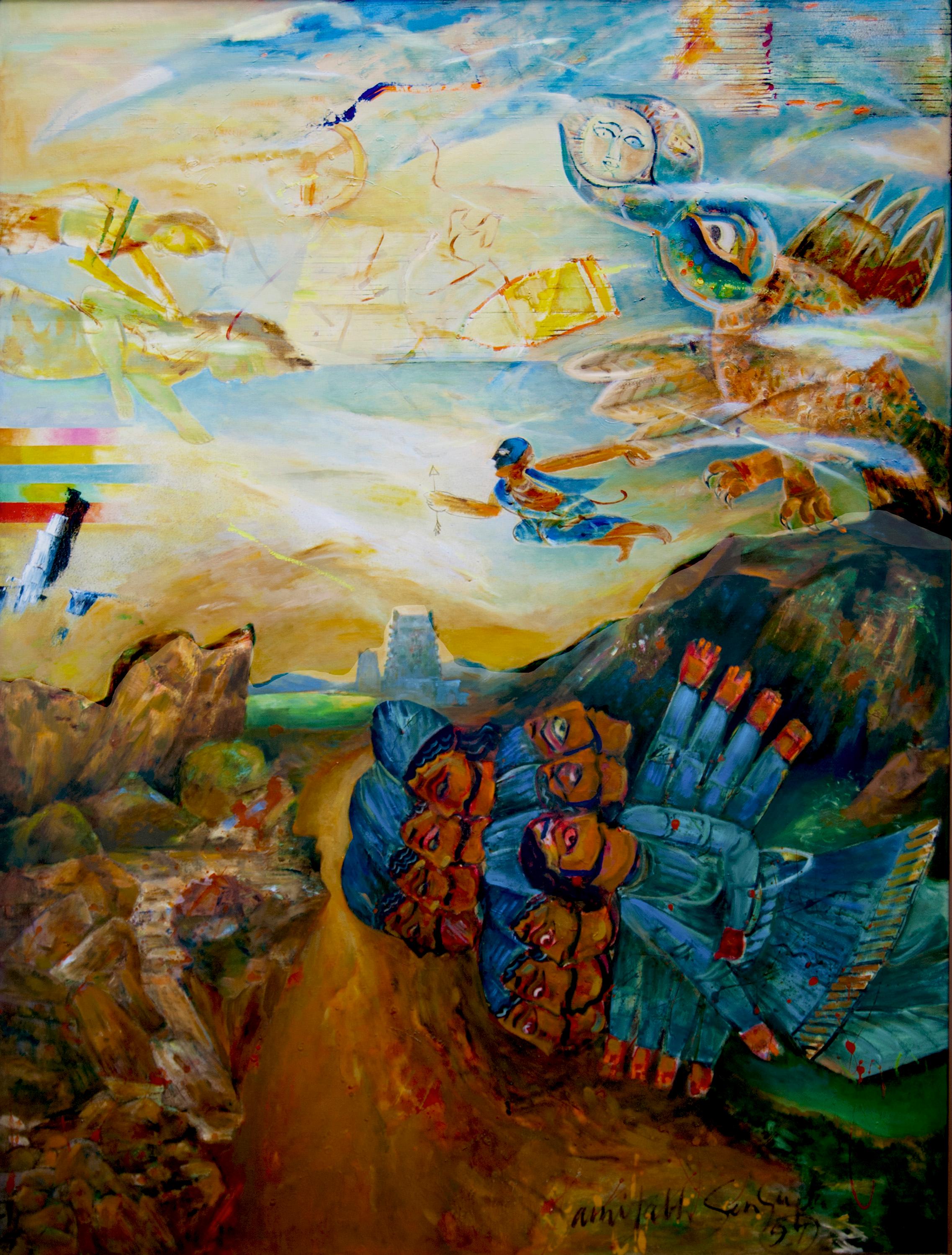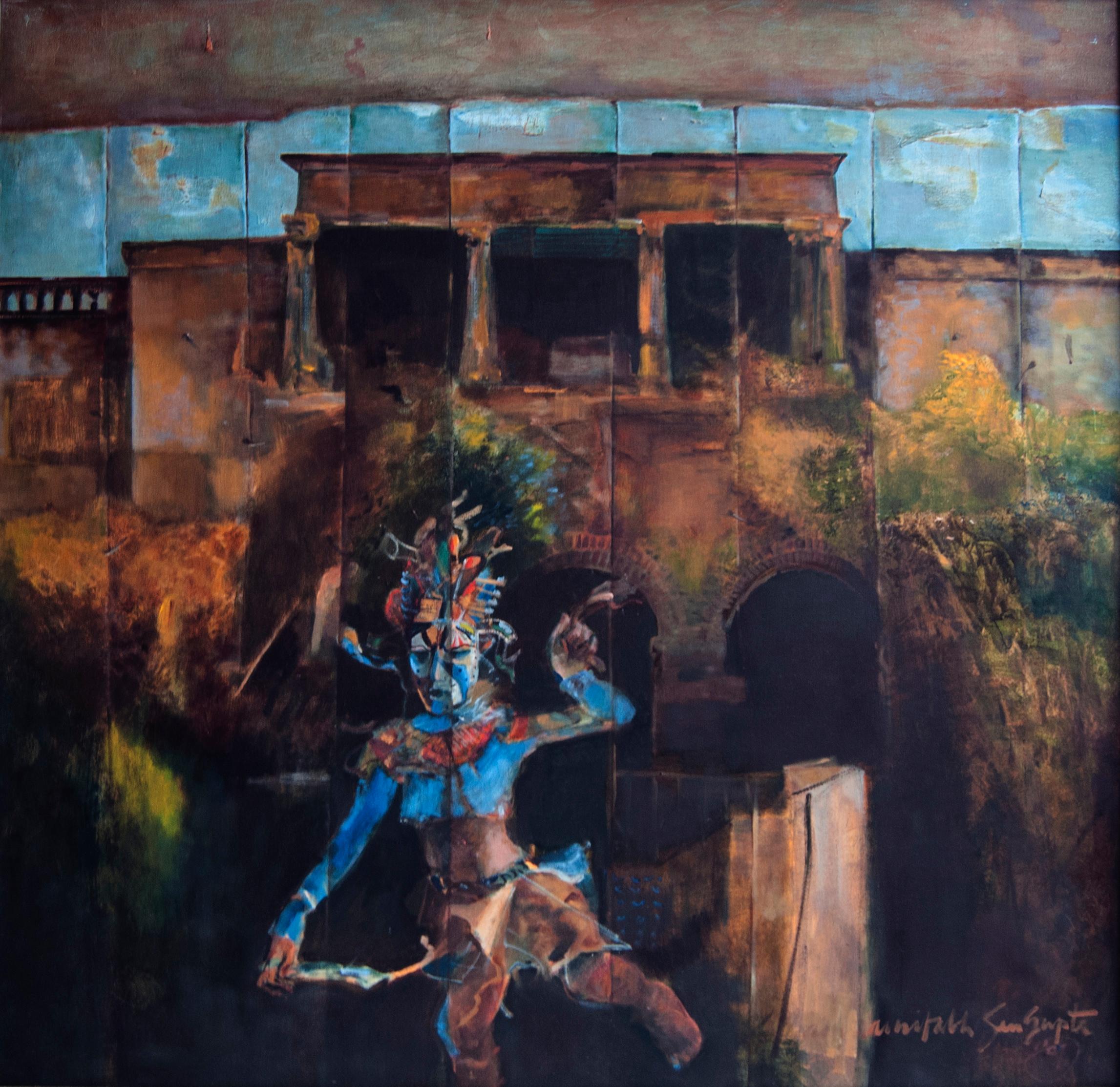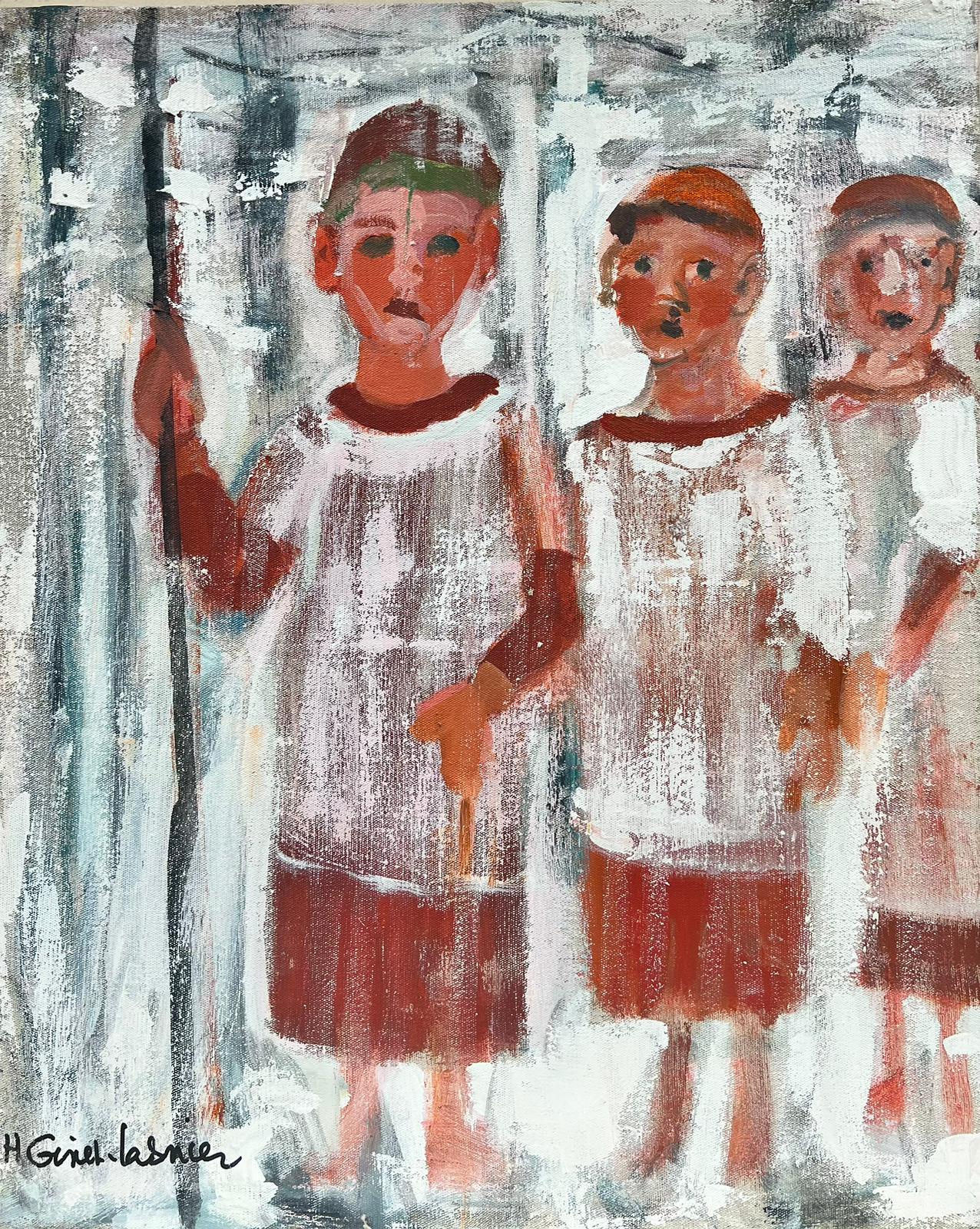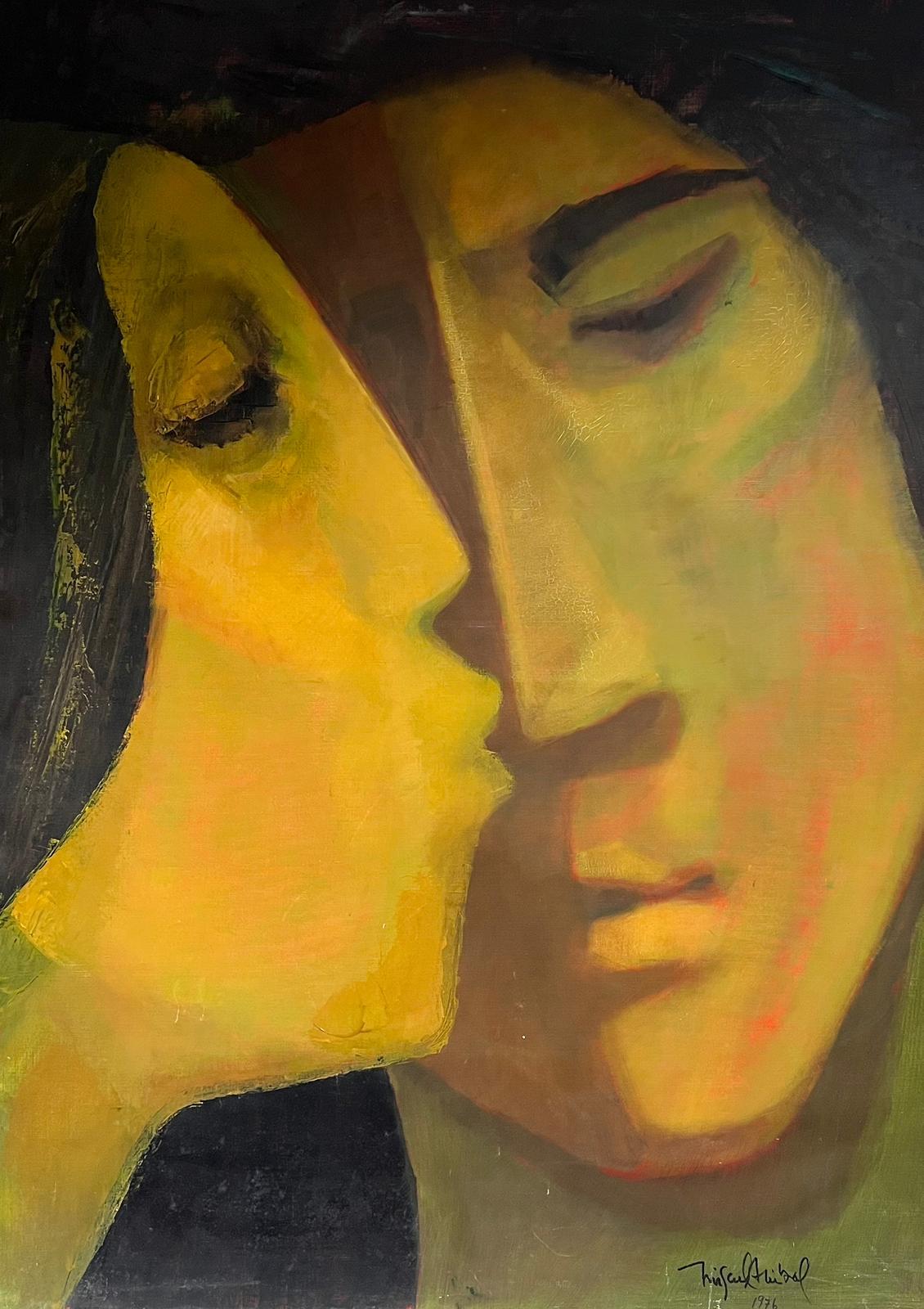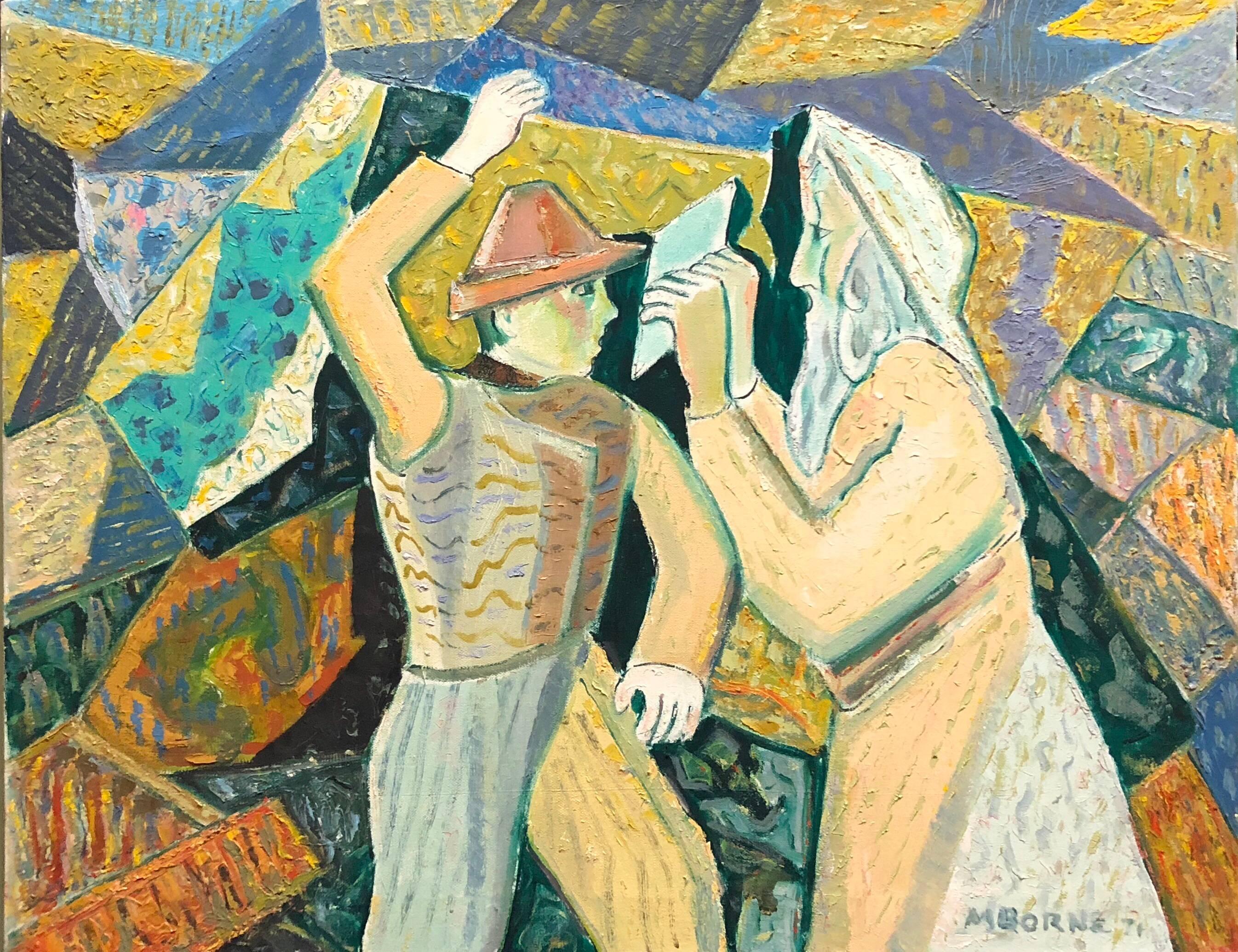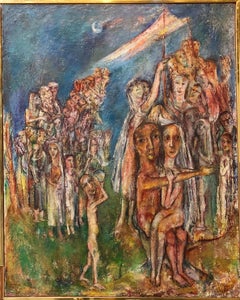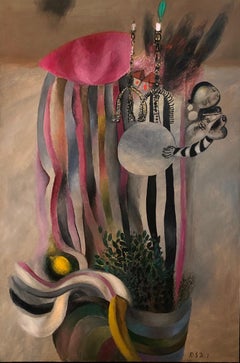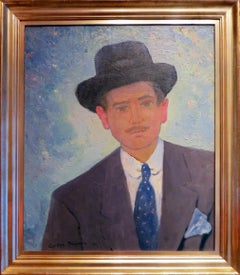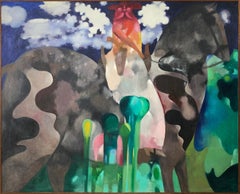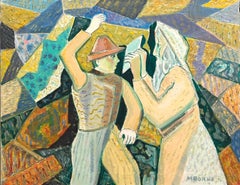
Judaica Modernist Oil Painting 'Know Thyself' Israeli Kibbutz Pioneer, Prophet
Want more images or videos?
Request additional images or videos from the seller
1 of 7
Mortimer Borne Judaica Modernist Oil Painting 'Know Thyself' Israeli Kibbutz Pioneer, Prophet1971
1971
About the Item
- Creator:Mortimer Borne (1902 - 1987, American, Polish)
- Creation Year:1971
- Dimensions:Height: 22 in (55.88 cm)Width: 28 in (71.12 cm)
- Medium:
- Movement & Style:
- Period:
- Condition:
- Gallery Location:Surfside, FL
- Reference Number:1stDibs: LU3822937133
About the Seller
4.9
Platinum Seller
These expertly vetted sellers are 1stDibs' most experienced sellers and are rated highest by our customers.
Established in 1995
1stDibs seller since 2014
1,543 sales on 1stDibs
Typical response time: 1 hour
More From This SellerView All
- Abstract Procession Jewish Wedding Chuppah Oil Painting Modernist JudaicaBy Sabina TeichmanLocated in Surfside, FLGenre: Modern Subject: Abstract Medium: Oil Surface: Canvas Country: United States Sabina Teichman: (1905-1983) Studied at Columbia Univ. (BA, MA), also with Charles J. Martin and A...Category
1950s American Modern Figurative Paintings
MaterialsCanvas, Oil
- Judaica Modernist Oil Painting 'Know Thyself' Israeli Kibbutz Pioneer, ProphetBy Mortimer BorneLocated in Surfside, FLMortimer Borne, Printmaker, painter, sculptor, and educator was born in Rypin, Poland in 1902 and emigrated to the US in 1916. He studied at the National Academy of Design, The Art Students League, The Beaux-Arts Institute of Design, and with Charles Webster Hawthorne, founder of the Cape Cod School of Art in Provincetown. Painted in a thick impasto style similar in technique to Samuel Rothbort and David Burliuk. Borne himself taught at The New School for Social Research in New York City from 1945-1967. From the 1920s through the 40s he was a prolific producer of New York City cityscapes and genre scenes. In later decades, he adopted a more modernist style apparently influenced by Picasso, producing color drypoints of abstracted figures. His works were widely exhibited in museums in the U.S. and abroad from 1931 and later, including the Art Institute of Chicago, the American Institute of Graphic Arts, Museum of Modern Art, Metropolitan Museum of Art, Corcoran Gallery of Art, New York Public Library, Carnegie Institute, and Royal Society of Painters, Etchers and Engravers in London. He taught at The New School for Social Research in New York City from 1945-1967, and at the Tappan Zee...Category
1970s Modern Figurative Paintings
MaterialsCanvas, Oil
- Israeli Surrealist Judaica Abstract Oil Painting Naftali Bezem Bezalel SchoolBy Naftali BezemLocated in Surfside, FLShabbat Evening Large Israeli masterpiece painting. Hand signed lower right Provenance: Sara Kishon Gallery Naftali Bezem (Hebrew: נפתלי בזם; born November 27, 1924) is an Israeli painter, muralist, and sculptor. Bezem was born in Essen, Germany, in 1924. His early adolescence was spent under German Nazi oppression, in constant fear for the safety of his parents, who perished in the Holocaust in the Polish Auschwitz concentration camp. Naftali emigrated to Mandate Palestine in 1939, at the age of fourteen with a Youth Aliyah group. From 1943 to 1946, he studied art at the Bezalel Academy of Art and Design in Jerusalem with Israeli painter Mordecai Ardon. He then spent three years studying in Paris. His most famous public works include a mural wall relief sculpture at Yad Vashem, the Israeli Holocaust museum and commemoration in Jerusalem and the ceiling painting mural in the main reception room at the President's Residence, Jerusalem, Israel. He is also known for his stained glass windows and Aubusson style flat weave tapestry in many public and private places around the world. In 1957, Bezem was a co-recipient of the Dizengoff Prize for Painting. Exhibitions: General Exhibition, Art in Israel 1960 Tel Aviv Museum of Art Artists: Naftali Bezem, Nachum Gutman, Shraga Weil, Shraga, Marcel Janco, Ruth Schloss Yad Labanim Museum, Petach Tikva with David Azuz, Nachum Gutman, Moshe Gat, Shraga Weil, Lea Nikel, Ruth Schloss, Yosl Bergner, Anna Ticho, and Menashe Kadishman. Old and New in the Museum Collection, Yad Labanim Museum, Petach-Tikva Jacob El Hanani, Naftali Bezem, Yosl Bergner, Yossef Zaritsky, Yohanan Simon, Reuven Rubin, David Rakia...Category
20th Century Modern Abstract Paintings
MaterialsCanvas, Oil
- Polish French Ecole de Paris Mid Century Modernist Oil Painting Clown JugglerBy Abram KrolLocated in Surfside, FLAbram Abraham Krol was born January 22, 1919, in Pabianice (Lodz), Poland. Abram Krol went to France in 1938 to study civil engineering at the University of Caen. In 1939 at the beginning of World War II he joined the Foreign Legion. After he was demobilized, he became a mechanic in a garage in Avignon. Although Jewish, he survived the war with a false identity. In 1943, Krol started studying to be an artist, taking courses in sculpture at the city’s School of Fine Art. He also began studying painting and self-described himself as a “Sunday painter.” Krol moved to Paris in 1944. The first exhibition of his work was in 1946 in the Katia Granoff Gallery in Paris. After the war, Krol took up engraving, studying that art form with an engraver he met in Paris. Krol reflected his Hasidic childhood often using Biblical themes in his art works. He said, During all my years of childhood I had read the Bible endlessly. I came back to the Bible because I was on solid ground there. It was part of the assertion of my own truth after a time of complacency. It seemed to me that in painting or engraving there were so many reefs to avoid, so many possibilities of setback, that I had to have all the odds in my favor do what I could—say what I had to say. Krol illustrated over 20 literary works from the late 1940s through the 1960s. He also engraved medals for the Paris mint and painted murals for schools in France. He designed tapestries and painted approximately 200 enamels. Museums and libraries which own Krol’s art works include the Bibliotheque Nationale in Paris; the Victoria and Albert Museum in London; the British Museum; Houghton Library, Harvard; Bodleian Library, Oxford, and the Palace of the Legion of Honor in San Francisco. Krol has had numerous one-man shows throughout Europe, Brazil, and in California. In 1960, Krol was invited to the Venice Biennale. He was awarded the Critics Prize in 1958. He also won the Feneon Prize among other honors. Krol died on October 9, 2001. The School of Paris, Ecole de Paris, was not a single art movement or institution, but refers to the importance of Paris as a center of Western art in the early decades of the 20th century. Between 1900 and 1940 the city drew artists from all over the world and became a centre for artistic activity. School of Paris was used to describe this loose community, particularly of non-French artists, centered in the cafes, salons and shared workspaces and galleries of Montparnasse. Before World War I, a group of expatriates in Paris created art in the styles of Post-Impressionism, Cubism and Fauvism. The group included artists like Pablo Picasso, Marc Chagall, Amedeo Modigliani and Piet Mondrian. Associated French artists included Pierre Bonnard, Henri Matisse, Jean Metzinger and Albert Gleizes. The term "School of Paris" was used in 1925 by André Warnod to refer to the many foreign-born artists who had migrated to Paris. The term soon gained currency, often as a derogatory label by critics who saw the foreign artists—many of whom were Jewish—as a threat to the purity of French art. Art critic Louis Vauxcelles, noted for coining the terms "Fauvism" and "Cubism", Waldemar George, himself a French Jew, in 1931 lamented that the School of Paris name "allows any artist to pretend he is French. it refers to French tradition but instead annihilates it. The artists working in Paris between World War I and World War II experimented with various styles including Cubism, Orphism, Surrealism and Dada. Foreign and French artists working in Paris included Jean Arp, Joan Miro, Constantin Brancusi, Raoul Dufy, Tsuguharu Foujita, artists from Belarus like Michel Kikoine, Pinchus Kremegne, and Jacques Lipchitz, the Polish artist Marek Szwarc and others such as Russian-born prince Alexis Arapoff. A significant subset, the Jewish artists, came to be known as the Jewish School of Paris or the School of Montparnasse. The core members were almost all Jews, and the resentment expressed toward them by French critics in the 1930s was unquestionably fueled by anti-Semitism. Jewish members of the group included Emmanuel Mané-Katz, Chaim Soutine, Adolphe Féder...Category
1950s Modern Figurative Paintings
MaterialsCanvas, Oil
- Large Archie Rand Abstract Expressionist Cartoon Oil Painting DusseldorfBy Archie RandLocated in Surfside, FL"Dusseldorf, Germany" 1993, oil on canvas, hand signed and dated lower left, Canvas (unframed):18 X 48. framed: 19.5 X 49.5 Provenance: directly from the artist. Exhibited at Phyllis Kind Gallery in NYC in 1987. Archie Rand (American, born 1949) is an artist from Brooklyn, New York. Rand's work as a painter and muralist is held in the collections of the San Francisco Museum of Modern Art, the Art Institute of Chicago, the Victoria and Albert Museum in London, the Bibliothèque Nationale de France in Paris, and the Tel Aviv Museum of Art. His graphic works and books are held by the Metropolitan Museum Of Art, the Museum of Modern Art, the Whitney Museum of American Art, the Art Institute Of Chicago, The Brooklyn Museum, the Baltimore Museum of Art, the Smithsonian Institution, and The New York Public Library; and are owned by Harvard, Yale, Columbia, Brown, and Johns Hopkins universities. Born in Brooklyn, Rand received a Bachelor of Fine Arts in cinegraphics from the Pratt Institute, having studied previously at the Art Students League of New York. His first exhibition was in 1966, at the Tibor de Nagy Gallery in New York. He has since had over 100 solo exhibitions, and his work has been included in over 200 group exhibitions. He is currently Presidential Professor of Art at Brooklyn College which granted him the Award for Excellence in Creative Achievement in 2016. Before joining Brooklyn College, Rand was the chair of the Department of Visual Arts at Columbia University. The Italian Academy For Advanced Studies in America at Columbia University presented him with The Siena Prize in 1995. He was awarded a Guggenheim Foundation Foundation Fellowship in 1999 and was made a Laureate of the National Foundation for Jewish Culture, which awarded him the Achievement Medal for Contributions in the Visual Arts. In 2002 he received the Presidential Award for Excellence in Teaching from Columbia University. In 2002 he became the artistic advisor to film director Ang Lee for his production of The Hulk, and was asked by Milestone Films to provide a commentary track for the DVD release of Henri-Georges Clouzot’s classic 1955 film The Mystery of Picasso. Archie Rand’s earliest major works are “The Letter Paintings” (or “The Jazz Paintings”) (1968–71), a radically positioned series of technically inventive, mural-sized canvases. The Letter Paintings, by incorporating the names of mainly male and female African-American musicians, undermined prevailing aesthetic categories by conflating many contemporary movements including Conceptual Art, Color Field, Pattern and Decoration, diary entry and social commentary. In 1974 Rand received a commission from Congregation B’nai Yosef in Brooklyn. Rand was asked to paint thematic murals on the complete 16,000-square-foot (1,500 m2) interior surfaces of the synagogue. The work took three years, and completing this commission made Rand the author of the only narratively painted synagogue in the world and the only one we know of since the 2nd Century Dura-Europos. The religious legal controversy raised by placing wall paintings in a traditionally iconoclastic space was resolved by the verdict of Rabbi Moshe Feinstein, then considered to be the world’s leading Talmudic scholar, who declared the paintings to be in conformity with the law. His subsequent turn to figuration may have been influenced by his friendship with Philip Guston, whose own work was transformed in the late 1960s. Like Guston, Rand "chafed at the limitations of purely abstract forms." A near-cult figure who started out as a child prodigy and whose admirers range from John Ashbery to Julian Schnabel. Rand’s paintings display a vast and savvy menu of inventive and finely executed approaches. He has completed many series after the works of Paul Celan, Moyshe-Leyb Halpern, Eugenio Montale, Yehuda Amichai, Rainer Maria Rilke, Samuel Beckett/Paul Eluard and Jack Spicer. Working often with poets, he has produced books and continues to engage in publishing collaborative projects. He maintained a correspondence with the American British Jewish painter R.B. Kitaj. In 2008, on a warehouse wall, Rand mounted the painting, “The 613”, which at 1700 square feet (17’ x 100’) is nearly twice the size of James Rosenquist’s F-111. It is one of the largest freestanding paintings ever made. Reminiscent of “The Segments” paintings it is intimidatingly enormous. Paradoxically, despite the raucous cartoony bytes that shoot colorful flashes from the manic surface, “The 613” glows warmly. Its overall effect is strangely calming and majestic. In an article on a 2011 exhibition of Rand's "Had Gadya" series, David Kaufmann wrote: Rand displayed his work in 15 solo exhibitions between 2008 and 2017, many of them showcasing paintings done after Scripture, or his workings with poets: Including “Had Gadya, 2005”, Borowsky Gallery, Philadelphia, PA (2011); “Gods Change, Prayers Are Here To Stay (after Yehuda Amichai), 2000", Katz Gallery, Atlanta, GA (2014); “Psalm 68, 1994”, Derfner Museum, Riverdale, NY (2014); “The Chapter Paintings”, Tribeca Gallery, NY (2015); “Men Who Turn Back (after Eugenio Montale), 1995", SRO Gallery, Brooklyn, NY (2016); “Sixty Paintings From the Bible” & “The Book of Judith, 2012”, Cleveland State University Galleries, Cleveland, OH (2016) & The American Jewish Museum, Pittsburgh, PA (2017); “Archie Rand: Early Works With Poetry: Jack Spicer, 1991 and Samuel Beckett/Paul Eluard, 1993”, St. Francis College, Brooklyn, NY (2017). "The 613" In 2015 Blue Rider/Penguin/Random House published The 613, allotting one color plate per page for each of the 614 units in the painting. The Wall Street Journal labeled The 613 as “dynamic…remarkable…thrilling” The New York Times selected the book as “Editors' Choice” and praised it in two separate reviews calling it “wonderfully garish” and declaring that “nothing prepared the art world for 'The 613.' Recent Activity In 2016 Rand showed two bodies of work that were done in Italy, “La Certosa Di Pontignano, 1995” and “Mount Etna, 2005,” at The Interchurch Center Galleries, New York. From 2016 to 2017 he served as the Curator and Juror for the Governor of Wyoming’s Capitol Arts Exhibition at The Wyoming State Museum, Cheyenne, WY. A 2017 exhibition, “Archie Rand: Early Works With Poetry”, featured two series of work from 1991 and 1993 after poems by Jack Spicer and Samuel Beckett/Paul Eluard. This painting was exhibited in the Phyllis Kind Gallery in NY in 1987. (Phyllis Kind was an American art dealer active in Chicago and New York. She promoted the work of the Chicago Imagists, The Monster Roster and The Hairy Who and outsider artists. Kind opened a gallery in Chicago in 1967. Called Pro Grafica Arte, the gallery dealt in master prints and drawings. In 1975, she opened a gallery on Spring Street in New York's SoHo district. She gave some of the artists in the movement their first solo shows: Jim Nutt and Gladys Nilsson...Category
1980s American Modern Figurative Paintings
MaterialsCanvas, Oil
- Large Oil Painting Israeli Pinchas Litvinovsky Jerusalem Israel Bezalel SchoolBy Pinchas LitvinovskyLocated in Surfside, FLPinchas Litvinovsky (Russian/Israeli, 1894-1985) A group of people, Jerusalem Types Hand signed indistinctly (lower right) in English and in Hebrew Verso. Oil on canvas Dimensions 16 1/8 x 51 1/16in Pinchas Litvinovsky (1894-1985) was a prominent Israeli painter, born in the Russian Empire (now Belarus) in Novo-Georgiyevsk, Russia. As a student he visited the Bezalel exhibition in Odessa and met Boris Schatz, the founder of the Bezalel School of Arts and Crafts. Schatz persuaded the young, talented student to study art in Jerusalem at Bezalel. He immigrated to Palestine in 1911, where he became a key figure in the local art scene and was among the pioneers of Israeli art. Litvinovsky studied art in Odessa and later in Paris at the Académie Julian. In the 1930’s he traveled to Paris, France where he encountered the art of Henri Matisse, Pablo Picasso and artists of the Ecole Juif Jewish School of Paris. (Marc Chagall, Modigliani, Chaim Soutine). Litvinovsky worked in many modernist styles, especially Cubism as reflected in the Russian constructivist paintings of the 1920’s His work, which includes landscapes, portraits, and biblical scenes, reflects a blend of European influences and Middle Eastern motifs. He was a member of the Bezalel group of artists and participated in the establishment of the Tel Aviv Artists' House. Throughout his career, Litvinovsky's art evolved, but he remained dedicated to exploring the unique light and landscapes of Israel, contributing significantly to the cultural fabric of the young nation. Select Group exhibitions Jewish Artists Association, Levant Fair, Tel Aviv, 1929 Artists: Arie Allweil, Ludwig Blum, Nachum Gutman, Itzhak Frenel Frenkel, Reuven Rubin, Shmuel Schlezinger, Eged - Palestine Painters Group, Allenby Street, Tel Aviv, 1929 Artists: Chana Orloff, Abraham Melnikoff, Sionah Tagger, Elias Newman, A Collection of Works by Artists of the Land of Israel The Bezalel National Museum, Jerusalem, 1940 Artists: Moshe Mokady, Jakob Steinhardt, Anna Ticho, Joseph Budko, Mordecai Ardon, Moshe Castel, Abel Pann, Hermann Struck, Rina Gallery, Jerusalem Artists: Motke Blum, Efraim Fima (Roytenberg, Ephraim) Zelig Segal, David Sharir, Joseph Halevi, David Caftori, Menashe kadishman, Dedi Ben Shaul, Raffi Lavie Exposition des Artistes de Jérusalem Grand Palais, Paris, France Artists: Samuel Ackerman, Marek Yanai, Zvi Tolkovsky, Zvi Miron Sima...Category
20th Century Modern Abstract Paintings
MaterialsCanvas, Oil
You May Also Like
- Signed Antique American School Modernist Cubist Jazz Piano Original Oil PaintingLocated in Buffalo, NYVintage American modernist abstract piano painting. Oil on canvas, circa 1940. Signed. Framed. Image size, 24"L x 20"H.Category
1940s Modern Abstract Paintings
MaterialsCanvas, Oil
$1,516 Sale Price20% Off - "Pinky"By Gershon BenjaminLocated in Lambertville, NJAshley John is proud to offer this artwork by: Gershon Benjamin (1899 - 1985) Gershon Benjamin is a painter of portraits, landscapes, still lives, and the urban scene. He had a pro...Category
20th Century Modern Abstract Paintings
MaterialsCanvas, Oil
- 1988 "Utopia" Abstract Oil Painting on Canvas Illustrator Bill ShieldsLocated in Arp, TXWilliam Stephens Shields, Jr., 1925 - 2010 "Utopia" 1988 Oil on canvas 60"x48" artist framed Signed lower right William Stephens Shields, Jr., 1925 - 2010 He was born in san Francisco, in 1931, Bill moved to Texas, where he grew up. Moved to New York in 1940 and later joined the Naval Air Corps at the age of 18. He served as an Aviation Cadet in the U.S. Navy from 1943 to 1945. At the end of WWII, Bill returned to Texas. At 21, Bill re-focused his energy and enrolled in the Chicago Academy of Fine Art as an Illustration major. What followed was a whirlwind of success, great friendships and a sense of belonging he had never before experienced. Art was his calling and the art-world could not have been less prepared for the likes of Bill Shields...Category
Late 20th Century American Modern Abstract Paintings
MaterialsCanvas, Oil
- "Pink Triangle" "Pink Triangle" 1950s Bay Area Figurative Movement Female ArtistLocated in Arp, TXFrann Spencer Reynolds (1926-2008) "Pink Triangle" c 1950s Oil on canvas 24"x32" float mount white distressed wood frame 26"x34.25" Signed on reverse Go...Category
Mid-20th Century American Modern Abstract Paintings
MaterialsCanvas, Oil
- HugBy Louisa ChaseLocated in New York, NYLouisa Lizbeth Chase was born in 1951 to Benjamin and Wilda Stengel Chase in Panama City, Panama, where her father, a West Point graduate, was stationed. The family moved to Pennsylv...Category
20th Century American Modern Abstract Paintings
MaterialsCanvas, Oil
$25,000 - 'The Soul is Music' France, Provence, California, Post Impressionist Figural OilLocated in Santa Cruz, CASigned lower left, 'J.da Silveira' for Jose Da Silveira (French-American, born 1965), titled, 'The Soul is Music' and painted circa 2002. Additionally signed and titled, and with figural drawing, verso; Previously with: Chabot Gallery, Campbell, California Born in a tiny jungle village in Mozambique to a Portuguese bullfighter and the daughter of one of the leaders of the French Resistance...Category
Early 2000s Modern Figurative Paintings
MaterialsCanvas, Oil
Recently Viewed
View AllMore Ways To Browse
Israel Museum
Israeli Oil
Israel Oil
Oil Paintings 1971
Israeli Art Oil
Israel Oil Painting
Israeli Oil Painting
Israeli Oil Paint
Israeli Modern Paintings
1970 Modernist Painting
Chicago Modernist Painting
British Modernist Art
Painting Oil Jerusalem
Israeli Judaica
Oil Paintings Of Jerusalem
R 1971
Chicago Cityscape Paintings
Oil Paintings Cape Cod

